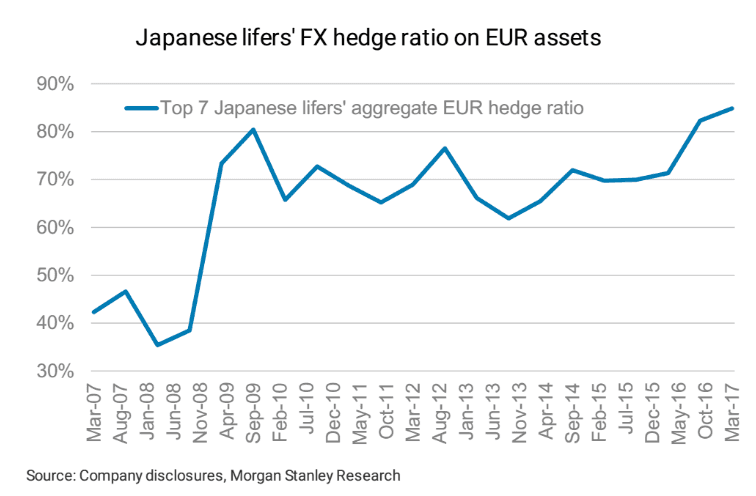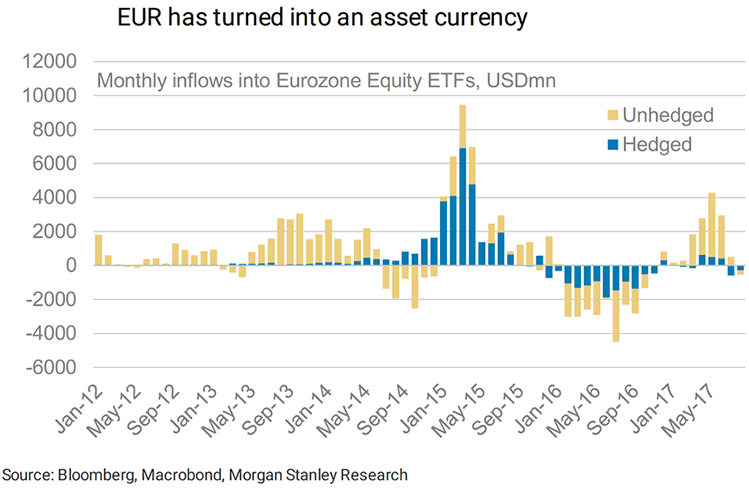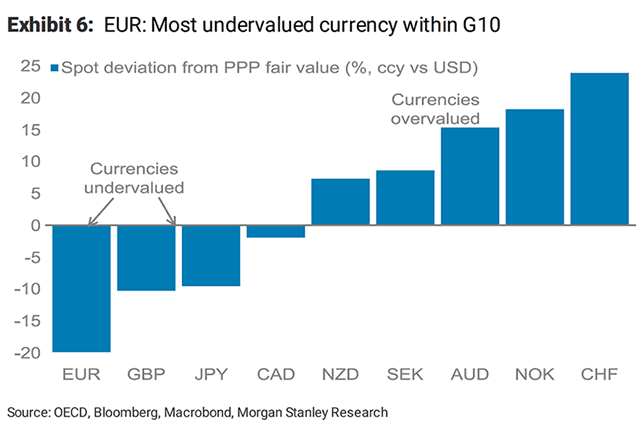British Pound to go Below 1.0 v Euro say Morgan Stanley: The Full Details

- A lingering threat of a Labour victory to weigh on Sterling sentiment
- Euro to benefit from pension and insurance fund investment
- Low-point for GBP/EUR seen in first quarter of 2018
- Current Pound to Euro rate spot: 1.1033, EUR/GBP: 0.9062, EUR/USD spot: 1.1766
An eye-raising forecast downgrade for the British Pound has been announced by one of the world's largest investment banks who warn the GBP/EUR exchange rate will fall below parity by early-2018.
Earlier this week we reported that Morgan Stanley had dropped their moderate view on the Pound to Euro exchange rate’s outlook and had turned decisively bearish.
We reported that strategist Hans W Redeker saw “profound” selling of the Pound ahead.
This view appears to have been a precursor to a material downgrade on their forecast targets as on Friday, August 11 the investment bank released their latest set of official foreign exchange forecasts and we can confirm they now see GBP/EUR falling below 1.0.
This makes Morgan Stanley the most bearish major investment bank on this exchange rate.
HSBC Holdings had previously held the title having long forecast 1.0 would be reached by year-end 2017; the Morgan Stanley call now ensures HSBC are no longer a market outlier.
As our collated GBP/EUR forecasts show market consensus is holding a year-end forecast for the pair closer to 1.12.
Why has Morgan Stanley Downgraded GBP/EUR?
The reasons are two-pronged: Euro strength and Sterling weakness.
Euro Strength
Real money investors may increase their exposure to Eurozone assets and the Euro say Morgan Stanley:
“Since the start of the year, the Fed's broad USD has lost 7%, pushing EURUSD up to our 1.18 year-end projection early. While USD is unlikely to maintain its current pace of downside momentum, we expect EUR to stay strong as pension funds and insurance companies (such as those in Switzerland and Japan) start to increase their net EUR currency exposure from historically low levels.”

Other reasons to back the Euro, as cited by Morgan Stanley include:
- The Euro has turned into an asset currency, as confirmed by the increasing FX-unhedged
inflows into EMU equities recently
- The ECB might lean against Euro strength, but will ultimately fail: Verbal intervention will be about winning time and not about a fundamental change in its current policy approach
- Eurozone fiscal and banking integration should allow for a higher valuation. No longer shall the EUR/USD reflect Italian fundamentals. It is also noted the Euro is the most undervalued major currency in the G10 and a return to fair-value must surely be inevitable, now could be the time for that recovery.

Pound Weakness
“GBP is likely to weaken in its own right, driven by weak economic performance, low real yields and increasing political risks,” says Morgan Stanley’s Redeker.
The analyst is wary that UK consumer spending can no longer be maintained at the levels that would justify trend-like growth in the economy. UK households are going to have to consolidate their balance sheets and this will suck momentum from economic growth.
Slowing wage increases will also weigh.
And then there is that now-familiar issue of political risk to consider:
Avoiding a cliff-edge - i.e. the UK embarking on a transitional period is already in the price of Sterling.
A Brexit transitional deal will immediately spark a rebellion amongst hard-core Brexiteers in Cabinet.
And, if the UK does go to the polls the chance of Labour victory, “would put GBP under immediate selling pressure.”
“The Labour Party’s agenda suggesting higher taxes on corporates and high income earners may weaken investment further, and may even lead to substantial capital outflows. GBP-denominated assets including housing may find it difficult to rally,” says Redeker.
Forecasts
Putting all the above together, Morgan Stanley forecast the Pound to Euro exchange rate at 1.02 at year-end, 0.98 by end-March 2018 and back to 1.02 by mid-2018.
The Pound to Dollar rate is forecast at 1.24 by year-end 2017, 1.23 by end-March 2018 and 1.23 by mid-2018.
Also getting an upgrade is the EUR/USD exchange rate which is now seeing up at 1.25 by the end of March 2018 with the end-2017 forecast residing at 1.22. However by mid-2018 the Euro will have faded back to 1.21.
Is the fall in value of Sterling impacting your international payments? Get up to 5% more foreign exchange by using a specialist provider by getting closer to the real market rate and avoid the gaping spreads charged by your bank for international payments. Learn more here.
Speculators Most Bullish on Euro Since 2011
The foreign exchange trading community might just have turned a little more optimistic on Pound Sterling according to the latest set of data into the workings of the foreign exchange market while bets for further Euro strength grew to their largest volume since 2011.
Weekly figures from the US Commodity Futures Trading Commission shows the speculative market holds bets against the Pound to the value of $2.043 BN.
While sizeable, this is however a decrease in contracts betting on Sterling weakness to the tune of $387 MN when compared to the previous week.
In short, negative positioning on Sterling decreased to the tune of $387 MN which represents a positive shift in sentiment.
Data from previous weeks suggested negativity was increasing; could the latest data suggest we have seen peak negativity in Sterling?
It is far too early to say what the data means for the Pound's outlook, particularly as the research community are expecting further declines in value of Sterling; for example this week Morgan Stanley researchers said the Pound to Euro exchange rate would fall below 1.0.
But the shift in sentiment is certainly one important clog in the engine of Sterling movement to keep in mind.
Sentiment towards the Euro remains unquestionably positive.
“EUR bulls upped exposure in net terms by 11k contracts (adding another USD1.6bn to the aggregate USD short) to 93.6k, the biggest bull bet on the EUR since 2011,” notes Shaun Osborne, Chief FX Strategist at Bank of Nova Scotia in Toronto.
This is the largest positive bet on the Euro since 2011.
And the Dollar continues to see increased negative sentiment:
“The latest snapshot of speculative FX positioning shows investors continue to add to USD short positioning in aggregate, with a further build in the overall USD short amounting to some USD4.5bn this week; the aggregate bear bet on the USD extends to USD15.6bn this week, the largest since 2013,” says Osborne.




